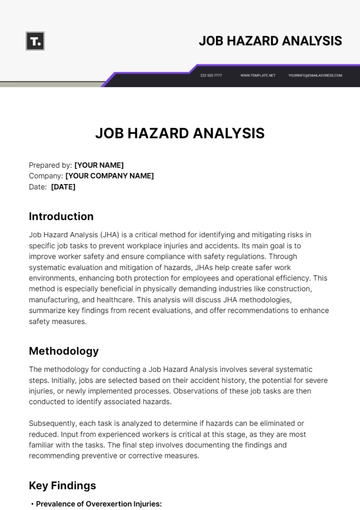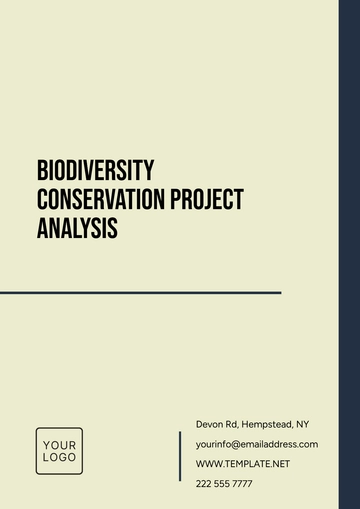Free Employee Relationship Risk & Opportunities Analysis HR

TABLE OF CONTENTS
1. Introduction .........................................................................................................3
1.1 Purpose of the Analysis ...............................................................................................3
1.2 Scope and Objectives .................................................................................................3
2. Methodology .......................................................................................................4
2.1 Data Collection ............................................................................................................4
2.2 Analysis Tools .............................................................................................................4
2.3 Participants ................................................................................................................5
3. Employee Relationship Risks ................................................................................6
3.1 Communication Challenges .........................................................................................6
3.2 Conflict and Tension ...................................................................................................6
3.3 Employee Disengagement ..........................................................................................7
3.4 Burnout and Well-being ..............................................................................................8
3.5 Diversity and Inclusion Concerns ................................................................................8
4. Opportunities for Improvement .............................................................................8
4.1 Enhanced Communication Strategies ..........................................................................8
4.2 Conflict Resolution Initiatives ......................................................................................8
4.3 Employee Engagement Programs ...............................................................................9
4.4 Well-being and Mental Health Support .......................................................................9
4.5 Inclusion and Diversity Initiatives ................................................................................9
5. Action Plan ..........................................................................................................9
5.1 Goals and Objectives ...................................................................................................9
5.2 Responsible Parties ...................................................................................................10
5.3 Timeline ....................................................................................................................10
5.4 Key Performance Indicators (KPIs) ............................................................................10
6. Conclusion .........................................................................................................10
1. Introduction
1.1 Purpose of the Analysis
The purpose of this Employee Relationship Risk & Opportunities Analysis is multifaceted, aiming to address critical aspects of our organization's employee relationships:
Identifying Potential Issues or Risks: One primary objective is to uncover any potential issues or risks that might hinder the productivity, morale, or overall well-being of our workforce. These issues can range from communication challenges to conflicts and employee disengagement, all of which can impact our organizational performance and employee satisfaction.
Highlighting Opportunities for Improvement: Equally important is the identification of opportunities for improvement. By delving into the intricacies of our employee relationships, we aim to unearth areas where enhancements can be made, leading to higher employee engagement, satisfaction, and a more positive work environment.
Strategic HR Planning: This analysis also plays a pivotal role in laying the groundwork for strategic HR planning. By understanding the current state of our employee relationships, we can better align our HR strategies and initiatives with the organization's goals, ensuring that we remain a preferred employer and maintain a competitive edge in attracting and retaining top talent.
1.2 Scope and Objectives
The scope of this analysis extends to all facets of employee relationships within our organization. It encompasses:
Interpersonal Dynamics: We aim to examine how employees interact with each other, their managers, and the organization as a whole. This includes assessing the quality of workplace relationships and collaboration.
Communication Channels: An evaluation of the effectiveness of our communication channels and tools is a critical component of this analysis. It seeks to identify any gaps or limitations in our current communication strategies.
Conflict Resolution: Identifying how conflicts are managed and resolved within the organization is another focal point. This involves examining whether there are adequate mechanisms in place for conflict resolution and whether they are accessible to all employees.
Employee Engagement Levels: We aim to assess employee engagement levels to determine if there are opportunities to increase employee motivation, satisfaction, and overall engagement with their work.
Employee Well-being: The well-being of our employees is a top priority. This analysis will explore aspects related to well-being, including work-life balance, mental health support, and stress management.
Diversity and Inclusion: Lastly, we will examine our diversity and inclusion efforts. This includes evaluating the representation of underrepresented groups, identifying potential areas of bias or discrimination, and assessing the effectiveness of our diversity and inclusion initiatives.
2. Methodology
2.1 Data Collection
The methodology employed for data collection in this analysis was comprehensive and multifaceted, ensuring that a holistic and accurate representation of our organization's employee relationships was obtained. The following methods were utilized:
Employee Surveys: A structured survey was distributed among employees across all departments. These surveys aimed to gauge employee sentiment, satisfaction levels, and perceptions related to various aspects of employee relationships. Open-ended questions allowed employees to provide detailed insights into their experiences.
One-on-One Interviews: In-depth one-on-one interviews were conducted with a diverse group of employees and managers. These interviews provided an opportunity to capture nuanced insights and gather qualitative data on interpersonal dynamics, communication, conflicts, engagement, and well-being.
Review of HR Records: Existing HR records, including performance evaluations, attendance, and diversity and inclusion reports, were analyzed. This quantitative data offered valuable insights into employee engagement, performance trends, and demographic information.
2.2 Analysis Tools
To derive meaningful insights from the data collected, a range of sophisticated analysis tools and techniques were employed. These tools included:
Statistical Analysis: Quantitative data from surveys and HR records were subjected to statistical analysis. This process involved the use of statistical software to identify trends, correlations, and patterns within the data.
Sentiment Analysis: Sentiment analysis was performed on the open-ended survey responses to gauge the overall sentiment and emotional tone of employees' feedback. This provided deeper insights into employee perceptions and concerns.
Qualitative Assessment: Qualitative data gathered from interviews was meticulously assessed. Themes, commonalities, and unique perspectives were identified through a rigorous qualitative analysis process.
Benchmarking: Benchmarking was employed to compare our organization's employee relationship metrics to industry standards and best practices. This helped in identifying areas where we can excel and areas that require improvement.
2.3 Participants
To ensure a comprehensive and diverse range of perspectives, participants in the data collection and analysis process included:
Employees: Employees from various departments, levels, and backgrounds were encouraged to participate in surveys and interviews. Their input provided insights into different organizational perspectives.
Managers: Managers and team leaders were actively involved in providing their viewpoints on employee relationships within their teams. Their insights shed light on leadership and management dynamics.
HR Professionals: HR professionals played a crucial role in coordinating the data collection efforts, ensuring that the analysis was aligned with HR objectives, and providing expertise in interpreting the findings.
Diversity and Inclusion Specialists: Diversity and inclusion specialists contributed to the analysis by focusing on diversity and inclusion concerns and providing guidance on addressing these issues.
3. Employee Relationship Risks
3.1 Communication Challenges
Communication challenges represent a significant area of concern within our organization's employee relationships. While communication is the lifeblood of any successful workplace, several notable challenges have been identified:
Inadequate Communication Tools and Platforms: Employees have expressed frustration with the effectiveness and suitability of our current communication tools and platforms. Some tools may lack the features necessary for transparent and efficient communication, hindering collaboration and information sharing.
Misalignment Between Management and Employees: Communication gaps between leadership and the broader employee base have emerged as a recurring issue. There appears to be a disconnect between the messages and priorities communicated by management and the perceptions and expectations of employees. This misalignment has the potential to create confusion, erode trust, and hinder effective decision-making.
Lack of Transparent Communication: Employees have highlighted concerns about the transparency of communication regarding company goals, changes, and decision-making processes. The perception of opaque communication can lead to uncertainty and speculation, which, in turn, can negatively impact morale and engagement.
Communication Overload: In some instances, employees have reported feeling overwhelmed by the volume of communication they receive, particularly through digital channels. This overload can lead to information fatigue, making it challenging to prioritize and act upon critical messages.
3.2 Conflict and Tension
Conflict and tension represent another critical area of concern within our organization's employee relationships. While conflicts are a natural part of any workplace, several notable challenges and risk factors have been identified:
Unresolved Conflicts: A recurring issue is the presence of unresolved conflicts within teams and between individuals. These conflicts often stem from differences in opinions, misunderstandings, or competition for resources. When conflicts linger without resolution, they can fester and negatively impact team dynamics, productivity, and overall morale.
Lack of Conflict Resolution Mechanisms: Employees have indicated that they may not be fully aware of or have access to effective conflict resolution mechanisms. This lack of clarity on how to address and resolve conflicts contributes to tensions within teams and departments.
Tension Arising from Differences: Differences in work styles, personalities, and communication preferences have been identified as sources of tension. While diversity in perspectives and approaches can be a strength, it can also lead to misunderstandings and interpersonal friction if not managed effectively.
Addressing conflict and tension is crucial to maintaining a harmonious and productive work environment. When conflicts are managed constructively, they can lead to innovation, improved decision-making, and stronger team cohesion. However, unresolved conflicts can erode trust, disrupt collaboration, and hinder overall performance.
3.3 Employee Disengagement
Employee disengagement is a concern that has been observed within our organization and warrants careful consideration. It encompasses various signs and indicators that suggest some employees may not be fully engaged in their work or may be experiencing decreased motivation and enthusiasm:
Low Employee Morale: A noticeable decline in employee morale has been identified in certain teams or departments. This decline can manifest as decreased enthusiasm for tasks, a lack of initiative, and a general sense of disinterest in the workplace.
Decreased Motivation and Enthusiasm: Employees have reported feeling less motivated and enthusiastic about their work. This decrease in motivation can translate into reduced productivity and lower quality of work.
Limited Opportunities for Growth: Some employees have expressed concerns about the limited opportunities for skill development and career growth within the organization. This perception of stagnation can contribute to disengagement.
Employee engagement is a critical factor in organizational success. Engaged employees are more likely to be committed, innovative, and aligned with the organization's goals. Conversely, disengagement can lead to decreased productivity, higher turnover, and a negative impact on overall workplace culture.
Addressing employee disengagement involves a multifaceted approach that considers factors such as job satisfaction, career development, recognition, and well-being. In the subsequent sections of this analysis, we will explore strategies and recommendations for improving employee engagement, creating a workplace that fosters motivation, and providing opportunities for growth and development.
It is important to recognize that employee engagement is closely intertwined with other aspects of employee relationships, including communication, conflict resolution, and well-being. As we progress in this analysis, we will consider how enhancing engagement can contribute to a more positive and productive work environment overall.
By addressing the factors contributing to employee disengagement proactively, we aim to reinvigorate our workforce, boost morale, and create an environment where employees feel motivated and inspired to contribute their best to our organization's success.
3.4 Burnout and Well-being
Concerns regarding employee well-being include:
High levels of burnout due to excessive workload.
Insufficient work-life balance.
Limited access to mental health support resources.
3.5 Diversity and Inclusion Concerns
Risks in diversity and inclusion encompass:
Perceived lack of diversity in leadership roles.
Instances of discrimination or bias.
Inadequate representation of underrepresented groups.
4. Opportunities for Improvement
4.1 Enhanced Communication Strategies
Opportunities for improvement in communication include:
Implementing more effective communication tools.
Conducting regular town hall meetings to share company updates.
Enhancing feedback mechanisms for employees to voice concerns and suggestions.
4.2 Conflict Resolution Initiatives
Opportunities to improve conflict resolution involve:
Providing conflict resolution training to employees and managers.
Creating a clear process for escalating and addressing conflicts.
Encouraging open and respectful communication to prevent conflicts from escalating.
4.3 Employee Engagement Programs
Opportunities for enhancing employee engagement include:
Introducing employee recognition programs.
Offering professional development opportunities.
Encouraging team-building activities to foster camaraderie.
4.4 Well-being and Mental Health Support
Opportunities for improving well-being and mental health support encompass:
Providing access to mental health resources and counseling services.
Promoting work-life balance through flexible work arrangements.
Educating employees on stress management and self-care techniques.
4.5 Inclusion and Diversity Initiatives
Opportunities to enhance diversity and inclusion involve:
Implementing diversity training programs.
Creating affinity groups and networks for underrepresented employees.
Setting diversity and inclusion goals and tracking progress.
5. Action Plan
5.1 Goals and Objectives
Goal 1: Improve communication by implementing a new communication platform within three months.
Goal 2: Reduce unresolved conflicts by providing conflict resolution training to all employees within six months.
Goal 3: Increase employee engagement by launching a recognition program within four months.
Goal 4: Enhance well-being support by offering mental health resources within two months.
Goal 5: Strengthen diversity and inclusion efforts by establishing diversity goals within five months.
5.2 Responsible Parties
Goal 1: The HR Department, IT Department, and Communication Team.
Goal 2: The HR Department and Training Department.
Goal 3: The HR Department and Employee Engagement Committee.
Goal 4: The HR Department and the Well-being Task Force.
Goal 5: The HR Department and Diversity and Inclusion Committee.
5.3 Timeline
A detailed timeline for each goal will be established and communicated to all relevant parties.
5.4 Key Performance Indicators (KPIs)
Key performance indicators will be defined for each goal to measure progress and success.
6. Conclusion
In conclusion, this Employee Relationship Risk & Opportunities Analysis highlights potential areas of concern and opportunities for improvement in employee relationships within the organization. The action plan outlined in this analysis aims to address these issues systematically and enhance overall employee satisfaction, engagement, and well-being.
- 100% Customizable, free editor
- Access 1 Million+ Templates, photo’s & graphics
- Download or share as a template
- Click and replace photos, graphics, text, backgrounds
- Resize, crop, AI write & more
- Access advanced editor
Discover seamless HR management with Template.net's Employee Relationship Risk & Opportunities Analysis HR Template. This editable and customizable template, available on Template.net, empowers you to assess and enhance employee relationships effortlessly. Unlock insights with ease using our Ai Editor Tool, making HR analysis a streamlined and efficient process. Elevate your workforce management today!





























